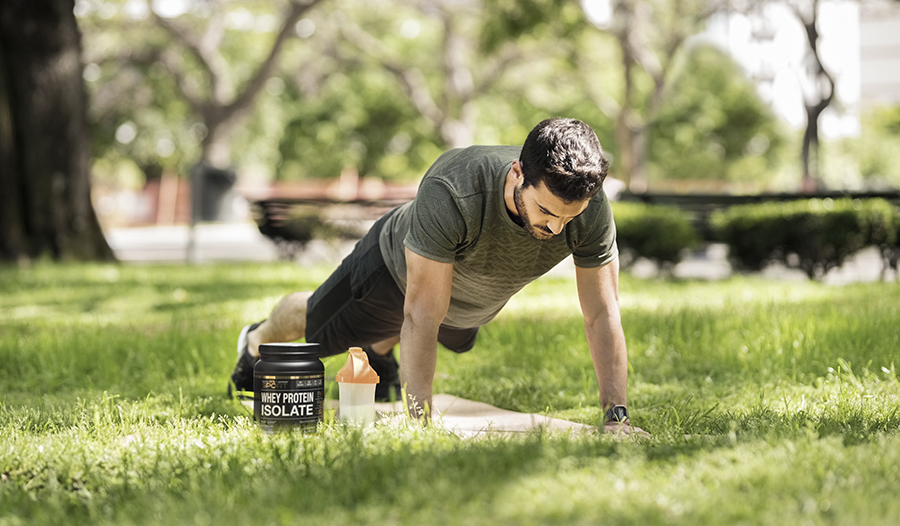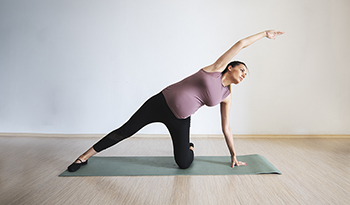9 Daily Habits to Help You Become Your Fittest Self in 2021
DISCLAIMER:This blog does not intend to provide diagnosis...
- In this article:
- What Are Habits?
- How to Create a New Habit
- Fitness, Nutrition, and Recovery Habits to Try

With the new year upon us you may be thinking about new healthy habits involving anything that will improve the quality of your life and health for the better.
Oftentimes, the beginning of the year serves as a major stepping stone for anyone trying to implement something that is likely going to take them out of their comfort zone and challenge them to some degree. These resolutions often involve fitness and nutrition, but they’re only as good as one’s ability to stick to them. Far too often, we set lofty, arbitrary “goals'' for ourselves without truly thinking about what it’s going to take to build the habits needed to accomplish those goals.
An example of this would be someone who says, “I’m going to start going to the gym five days a week and start a new diet.” While the motivation in this sentiment is awesome, you can probably guess what happens to most individuals who go from 0 to 100 similar to this after a month. They fall off.
In this article, we’re going to discuss what habits actually are, create a framework to help implement healthier habits in a realistic means, and highlight a list of awesome habits to try to implement.
What Are Habits?
Believe it or not, there is no right or wrong way to define what habits are, and in the world of research, "habit" has taken on multiple definitions per how one plans to use and implement the concept of habits.
From a coaching point of view, one definition that I like is, "A habit is a process by which a stimulus generates an impulse to act as a result of a learned stimulus-response association." Essentially, this means that the habits we form are simply products from strings of learned cues, and this type aligns perfectly with fitness and nutrition. That being said, it can be incredibly useful to disassociate our daily behavior with the new habits we’re trying to build.
Why? Well, behavior can be heavily dictated by our moods which ebb and flow, so if we build habits and subconsciously associate them with different behaviors, then we have the off chance of developing poor relationships with new habits and potentially negative behaviors.
Picture this: if we’re trying to form a new habit like going to the gym or eating slightly healthier and we only did these when we felt happy and motivated, then we could build a bias toward these new habits with these behaviors and feelings. We want to avoid that and disassociate behavior and habits because we’re different every day and we don’t want to rely on aligning so many variables to execute new habits.
Now, when it comes to physically forming new habits, the process gets a little more complex because it’s more than simply “starting something new.” As you create new habits, you will need to remain objective about how you respond to different cues and find what works best for you.
Research suggests habitual health behaviors often fall into three categories.
- Habits that are habitually initiated but consciously performed.
- Habits that are consciously initiated but habitually performed.
- Habits that are habitually initiated and habitually performed.
Category one would include putting your running shoes on after days of doing so right upon waking up in the morning, then consciously deciding to run a mile. Category two would entail opting to go to the gym on a regular basis. It's an initial conscious decision and for many, once they arrive at the gym, it's an automated habitual process of completing a prescribed workout. Category three would be eating junk food when you feel stressed. It's an unconscious decision that is a product of an unconscious stimulus.
If you notice something, all of these categories involve habitually initiating some activity to produce desired outcomes. This is why it’s important to create a string of cues in order to follow realistic habits based on feasible goals.
As you read on, try to think about the habits you want to form in the New Year, then use the framework we discuss to curate cues that work for your individual context. Remember, how I form habits will be different from how you form habits, but the cueing process will be similar.
How to Create a New Habit
New fitness habits can take many forms and that’s why it’s so important to nail down some specifics and give some thought to realistically deciding what you want to accomplish.
- Do you want to go to the gym more often?
- Do you want to add 10 lbs of muscle?
- Do you want to run your first marathon this year?
These are all great goals that can help initiate a new fitness habit, but these end goals don’t really help us build the steps needed to achieve them, nor do they help us build a realistic habit framework.
Form New Habits, Step-by-Step
Let’s use one of the examples above to provide you with an idea of how to format new fitness habits.
For the sake of commonality, let’s say you want to start going to the gym at least 3x a week throughout the entirety of 2021. That’s a lofty goal if you haven’t been going, especially when you consider that you’re going from 0 to 152 gym sessions to accomplish this goal. That’s an amount that will make anyone feel dizzy and this is even more true for those without a plan of attack.
Instead of trying to tackle the large goal right away, segment it out into three different sections. Create macro, meso, and micro goals that are designed to help ease you into new habits while also building cues to stimulate consistent habits.
An example of these goals could be:
- Micro goal: For the first month, go to the gym once a week and do two light 20-minute workouts at your home.
- Meso goal: For months two and three, go to the gym twice a week and do 1-2 light workouts at home.
- Macro goal: For month four through the end of 2021, try to attend the gym at minimum two times per week but aim for consistently getting to the gym three times per week.
This flow will help you ease into the process of going to the gym more frequently in a calculated means. It’s also completely normal to end up enjoying the process throughout the first few months and not needing this form of timeline! The point is to ease you into a habit change without overdoing it, then spinning your wheels.
After you’ve built your timeline of different goals, it’s time to build in cues to help assist with your adherence. Some useful cues that you could try are:
- Lay out your gym outfit with your training shoes before the day of your workout. Then, on the way to the gym listen to your favorite music and think about your workout.
- If you like having a stimulant before exercise, then look into various pre-workout supplements, and there are also stim-free pre-workout options for anyone that doesn’t like feeling jittery.
- At the gym, have a plan of attack and build a warm-up routine that you enjoy and helps your body feel prepped and ready.
- Your program should also align with your goals and make you excited. Then, by using a workout you can somewhat go autopilot and teach your body that this preparatory activity means go time.
- After the gym, consume healthy and flavor-packed snacks or protein shakes and smoothies.
- We want to reward ourselves for crushing our new habits, but we also want to be mindful of the bigger picture.
This is just one example of how you can structure cues to promote positive habits. By segmenting your goals and baking in cues that are realistic for you to follow, you can build long-term adherence toward habits you want to create.
Fitness, Nutrition, and Recovery Habits to Try
Below, you’ll find nine habits that are great starting points to build a habit framework around if you need a little habit motivation. Start with the examples below, then build cues that make sense for the context of your life.
1. Focus On Better Sleep
- The habit: Sleep at least 7-hours a night, but ideally work towards 8+.
- Possible cues: Setting a cooler temperature in your room, using melatonin to assist at the beginning, limiting blue light 30-min before bed, and putting your phone away earlier.
2. Build a Better Wind Down Routine
- The habit: Implement daily steps to calm down in healthy, feasible ways.
- Possible cues: Implementing 5-10 minutes of yoga, taking a magnesium supplement in the evening (the calming supplement), doing breathwork every other hour.
3. Construct Quality Meals
- The habit: Focus on building meals that align with your goals and provide the body with adequate nutrients.
- Possible cues: Find healthy staples that you enjoy for certain meals, make certain days of the week themed or inspired by, consume a quality protein source at every meal, and build meals off of it.
4. Move More Throughout the Day
- The habit: Work on increasing daily energy expenditure in a realistic means.
- Possible cues: Walk as soon as you wake up and have your shoes out from the night before, set a timer every hour to stand, stretch, and do some form of light activity.
5. Improve Post-Workout Nutrition
- The habit: Give more attention to your post-workout recovery nutrition in relationship to your goals.
- Possible cues: Plot out your post-workout meal before your lift, find a protein shake that you enjoy the taste of, and can have post-lift.
6. Cover All of Your Daily Nutrient Bases
- The habit: Make sure you’re covering nutrient bases you might fall short on some days.
- Possible cues: Supplementing with things like zinc, a multivitamin, and vitamin D in the morning, consuming various fruits and veggies at certain meals (depending on nutrition goals).
7. Dial In Your Morning Routine
- The habit: Start your day with a consistent, energy-focused flow.
- Possible cues: A consistent alarm, a small morning workout that you can easily tackle after waking up, drinking a glass of water with lemon and salt first thing.
8. Track Your Meals Consistently
- The habit: Regularly log your meals.
- Possible cues: Have an app out and ready to log meals before you eat, set reminders in your phone.
9. Log Your Workouts
- The habit: Log your workouts regularly to better track your progress.
- Possible cues: Set a reminder in your phone, set a number focused goal for how many times you want to log workouts and create a reward for doing so.
Breaking down your large goals into smaller, achievable steps will help you to stay on track and accomplish your 2021 resolutions. Happy New Year!
References:
- https://www.ncbi.nlm.nih.gov/pmc/articles/PMC4566897/

 By Jake Boly, CSCS
By Jake Boly, CSCS


